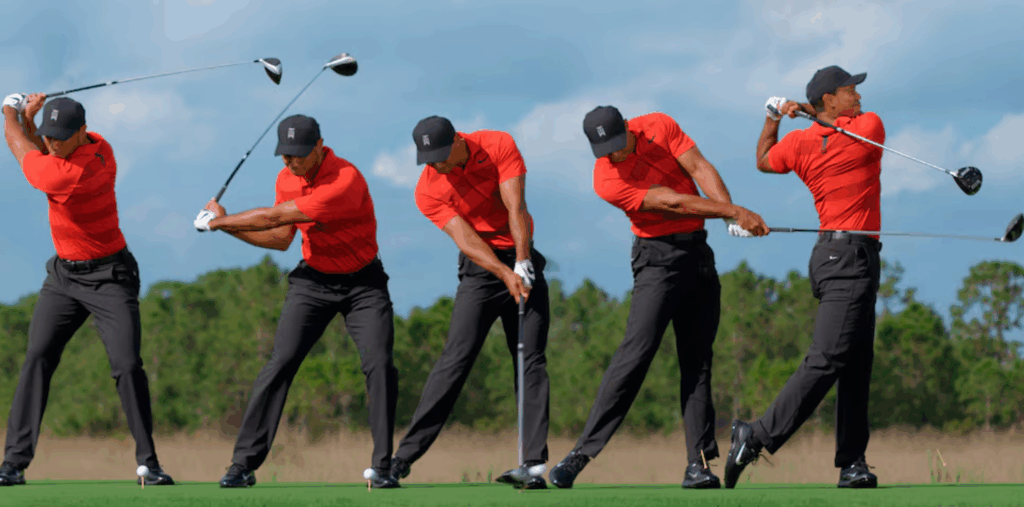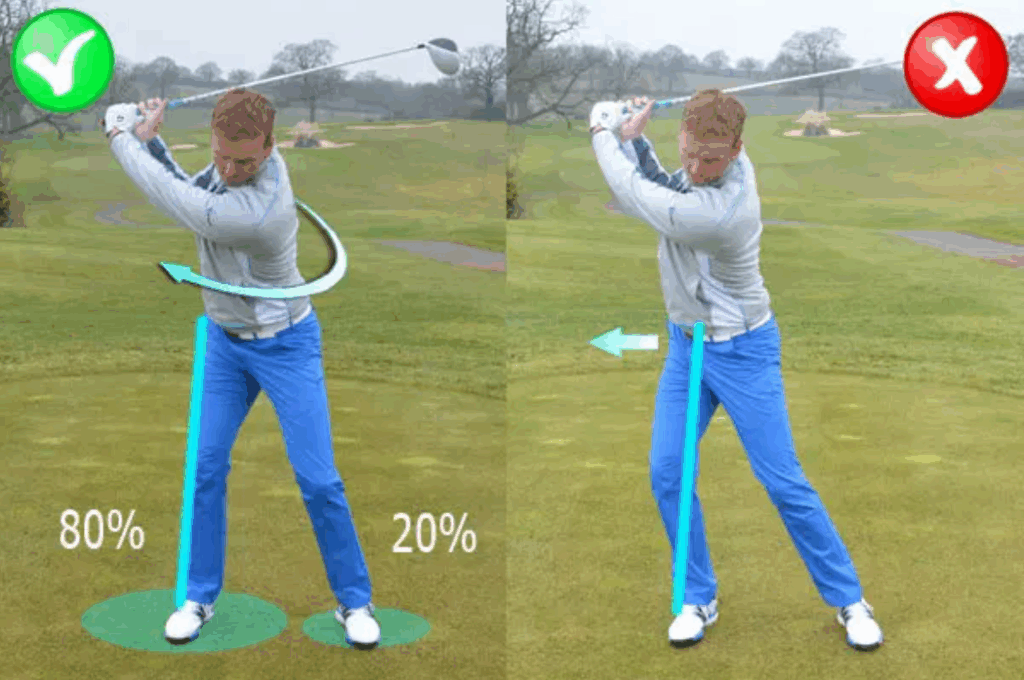To generate more power in your golf swing, focus on mastering the kinetic chain by sequencing properly from the hips to the clubhead. Transfer your weight effectively, starting with 60% on your back foot and shifting forward during the downswing. Use your lower body as your main power source through proper hip rotation. Create lag by maintaining wrist hinge longer, allowing hands to lead the clubhead at impact.
These smart techniques will boost your distance without requiring more physical effort.
Proper Sequencing for Maximum Power
Releasing power in your golf swing begins with understanding the kinetic chain, or the sequential transfer of energy from ground to club. This foundation is essential for generating explosive power without sacrificing accuracy.
Your swing should follow a specific kinematic sequence: hips first, then torso, followed by arms, and finally the clubhead. When these movements happen in the correct order, each segment accelerates and then transfers its energy to the next link in the chain. Most amateurs lose distance by initiating with their arms rather than their lower body.
Practice this sequence with slow-motion swings, focusing on starting rotation with your hips while keeping your arms relaxed. You’ll feel a more natural build-up of speed that transforms into effortless power at impact.

Perfect Weight Transfer for Distance
Weight transfer serves as the hidden engine behind every powerful golf swing. Without proper shifting from your back foot to your front foot, you’ll leave significant distance on the table. As you begin your backswing, shift roughly 60% of your weight onto your rear foot while keeping your core engaged and stable.
As you shift into your downswing, initiate the move with your lower body, allowing your weight to flow smoothly toward your target. Your core muscles should remain engaged throughout this motion, creating the tension necessary for explosive release.
Practice this weight transfer by hitting balls with your feet close together, forcing you to balance properly. You’ll immediately notice improved consistency and distance when you master this fundamental aspect of power generation.

Leverage Your Lower Body to Unlock Hidden Distance
Many golfers mistakenly focus on arm strength when the real power generator lies below their waist. Your lower body creates the foundation for explosive distance through proper sequencing and rotation.
Start by feeling your weight shift to your back foot during the backswing, then powerfully transfer it forward as you initiate the downswing. This weight transfer creates momentum that multiplies your swing speed considerably.
The key to revealing hidden yards lies in your hip rotation. Practice turning your hips fully away from the target on your backswing, then aggressively rotate them toward the target during your downswing. This rotation creates torque.
Place a club across your hips and practice rotating back and through while maintaining balance.
Optimize Your Swing Path for Effortless Power
While hip rotation and lower body leverage build your power foundation, your swing path determines how efficiently that power reaches the ball. An inside-out path promotes maximum energy transfer and reduces wasted motion that robs you of distance.
Focus on swing efficiency by keeping your clubhead traveling on the ideal path through impact. Place alignment sticks on the ground to create a channel guiding your club along the desired path. Take slow practice swings, feeling the difference between an efficient path and one that cuts across the ball.
Technique refinement happens gradually. Don’t force dramatic changes. Instead, make small adjustments that promote a smoother, more powerful delivery position. You’ll generate more distance without swinging harder, the hallmark of truly efficient power.

Create Lag and Release
Although amateur golfers often focus on swing speed, professionals know that creating lag and properly timing the release generate far more power than raw muscle. Lag is the position where your lead arm and the club shaft form an angle in the downswing, helping you generate and hold energy before impact.
To create effective lag, maintain wrist hinge longer in your downswing rather than casting the club early. Feel your hands leading the clubhead toward impact, then release that stored energy explosively through the ball. This sequencing multiplies power generation without additional effort.
Practice this timing by using half-speed swings with a focus on delaying the release until just before impact. Your clubhead speed will accelerate dramatically through the hitting zone, delivering that effortless distance professionals achieve with seemingly relaxed swings.
Frequently Asked Questions
How Does Grip Strength Affect Swing Power Without Losing Control?
You need moderate grip pressure, not excessive strength. Too tight restricts wrist hinge and reduces clubhead speed, while too loose sacrifices control. Find your sweet spot for maximum power transfer.
Can Swing Tempo Adjustments Increase Distance Without Changing Mechanics?
Yes, a smoother tempo can boost distance. You’ll generate more power by slowing your backswing and accelerating through impact. This timing shift creates better sequencing without changing your fundamental mechanics.
What Role Does Shoulder Flexibility Play in Power Generation?
Shoulder flexibility allows you to achieve a fuller backswing, increasing your swing arc and storing more potential energy. You’ll generate more clubhead speed through improved rotation and maintain better posture throughout your swing.
How Do Different Ball Positions Impact Power for Various Clubs?
Ball position affects power considerably. Place it forward in your stance for drivers to hit on the upswing. Move it progressively backward for shorter clubs to optimize downward impact and compression for maximum distance.
Can Mental Visualization Techniques Measurably Increase Swing Speed?
Yes, visualization techniques can measurably increase your swing speed. When you mentally rehearse perfect swings, you’re training neural pathways that improve your timing, coordination, and confidence, resulting in faster, more efficient movements.





